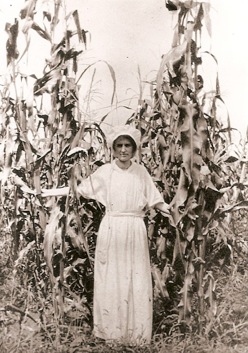I have an old Betty Crocker cookbook and in the section on yeasts it says: "In the old days, women made yeast at home--usually from 'hops' or, as some, from the 'emptins' of the beer keg. " I haven't found anything about Aunt Dora emptying a beer keg, but she does say this:
 In the fall we would search for hops. Mother made our yeast by combining hops, cornmeal, potatoes, salt and sugar. She would spread this mixture on a white cloth and place it in the sun to dry. She used a small chunk of it each time she baked bread.
In the fall we would search for hops. Mother made our yeast by combining hops, cornmeal, potatoes, salt and sugar. She would spread this mixture on a white cloth and place it in the sun to dry. She used a small chunk of it each time she baked bread.
She then goes on to talk about all the things they gathered from the fields and fence rows and I must say I am impressed. Two things stand out, however, there are no longer hazelnuts in the area and she never mentions hunting mushrooms. Jerry Birkby
All summer we hunted wild flowers, birds and berries. There were wild gooseberries in the woods and we always told Mother when they were ready to pick. The first afternoon she could leave the housework we would take a jug of water, some bread and butter or cookies and go "Gooseberrying." When we reached home again, the stemming of them was a long tedious job. Lucy and I always chose this time to feel sick.
In the fall, we would go into the woods back of our house to gather our winter’s supply of hazelnuts. We scattered them on the porch roof to dry and would shell them by hand without a care for the stain we would get on our hands.
We gathered some catnip and horehound and hung it up to dry. The former was used to make tea for babies and the latter to make a syrup or candy for colds.
Father and Walter would take a team and wagon to the woods to get a load of black walnuts. We’d scatter them on the ground to dry and would hull them by hand or with a stick. Later we used the hand corn sheller. We kids would crack and eat them about as fast as they would dry. It usually took several weeks to get a barrel ready for winter use.
At first the settlers of Southwest Iowa had to depend on the wild plums and berries for their fruit, but soon all had apple orchards and a wild plum thicket.
We had to help pick apples in the fall.
After we got our fruit cellar, we never stored less than about three hundred bushels. I have often thought since what geese we were to store so many when we never sold any, couldn't give them away
and never used half of them. We sorted them over in the spring and fed them to the hogs. The farmers were economical souls and couldn't bear to see anything go to waste except hard work. Years after
this when only John, my youngest brother, and I were left in the old home, we still carried out this idea of thrift and would store twenty-five bushels of apples every fall. As John said,
"Five to eat, ten to rot, and ten to give away."

